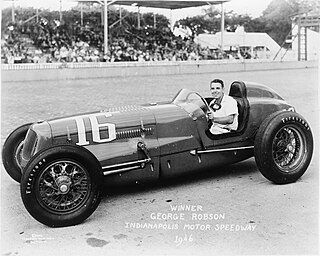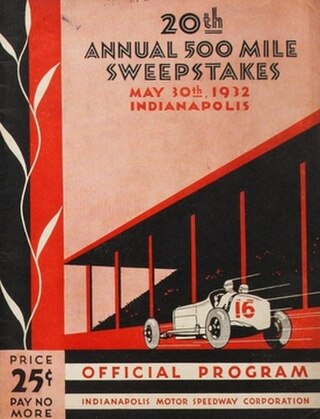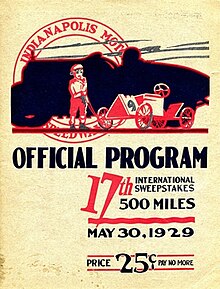
The 37th International 500-Mile Sweepstakes was held at the Indianapolis Motor Speedway on Saturday, May 30, 1953. The event was part of the 1953 AAA National Championship, and was race 2 of 9 in the 1953 World Championship of Drivers. Bill Vukovich, after falling just short a year before, dominated the race, leading 195 of the 200 laps. Vukovich won the first of two consecutive "500" victories, finishing more than three minutes ahead of second place Art Cross.

The 38th International 500-Mile Sweepstakes was held at the Indianapolis Motor Speedway on Monday, May 31, 1954. The event was part of the 1954 AAA National Championship Trail, and was also race 2 of 9 in the 1954 World Championship of Drivers.

The 39th International 500-Mile Sweepstakes was held at the Indianapolis Motor Speedway on Monday, May 30, 1955. The event was race 1 of 11 of the 1955 AAA National Championship Trail and was race 3 of 7 in the 1955 World Championship of Drivers.

The 40th International 500-Mile Sweepstakes was held at the Indianapolis Motor Speedway on Wednesday, May 30, 1956. The event was part of the 1956 USAC National Championship Trail and was also race 3 of 8 in the 1956 World Championship of Drivers. The 1956 race was the first to be governed by the United States Automobile Club. The AAA withdrew from auto racing the previous August after a succession of incidents, including the Le Mans disaster and the fatal crash of Bill Vukovich during the 1955 race. Another change was made to the track that would have an immediate effect on the racing. The vast majority of the circuit was paved over in asphalt. A short stretch approximately 600 yards in length was left brick along the mainstretch. Speeds were expected to climb, and qualifying records were expected to be shattered during time trials.

The 41st International 500-Mile Sweepstakes was held at the Indianapolis Motor Speedway on Thursday, May 30, 1957. The event was part of the 1957 USAC National Championship Trail and it was race 3 of 8 in the 1957 World Championship of Drivers.

The 42nd International 500-Mile Sweepstakes was held at the Indianapolis Motor Speedway on Friday, May 30, 1958. The event was part of the 1958 USAC National Championship Trail, and was also race 4 of 11 in the 1958 World Championship of Drivers.

The 53rd International 500 Mile Sweepstakes was an auto race held at the Indianapolis Motor Speedway in Speedway, Indiana on Friday, May 30, 1969. It was the third round of the 1969 USAC Championship Car season. Polesitter A. J. Foyt led the race in the early stages, looking to become the first four-time winner of the 500. Near the halfway point, however, a lengthy pit stop to repair a broken manifold put him many laps down. Despite a hard-charging run towards the end, he wound up managing only an eighth-place finish, 19 laps down. Lloyd Ruby, a driver with a hard-luck reputation at the Speedway, was leading the race just after the midpoint. During a pit stop, he pulled away with the fueling hose still attached, ripped a hole in the fuel tank, and was out of the race. The incident put Mario Andretti in the lead for rest of the way.

The 30th International 500-Mile Sweepstakes was held at the Indianapolis Motor Speedway on Thursday, May 30, 1946. This was the first Indianapolis 500 presided over by new track owner Tony Hulman. The track had closed in late 1941 due to World War II, and over the next four years, the facility fell into a terrible state of disrepair. Hulman purchased the Speedway in November 1945, and quickly went to work cleaning up the grounds, which had become overwhelmed by overgrowth and weeds. The Speedway re-opened, and the 1946 race was considered a rousing success.

The 7th Liberty 500-Mile Sweepstakes was held at the Indianapolis Motor Speedway on Saturday, May 31, 1919.
The 23rd International 500-Mile Sweepstakes Race was held at the Indianapolis Motor Speedway on Thursday, May 30, 1935. Despite attempts to improve participant safety by requiring crash helmets and installing green and yellow lights around the track, the event that year would prove to be one of the worst in terms of fatalities.

The 20th International 500-Mile Sweepstakes Race was held at the Indianapolis Motor Speedway on Monday, May 30, 1932. Attrition was the story of the race, with 26 of the 40 cars dropping out due to crashes or mechanical failure. A record eight different drivers led laps during the race, with no driver seemingly able to hold the lead without experiencing some sort of trouble. For the third year in a row, Billy Arnold looked as if he would be the dominant car, but he sailed over the turn three wall on lap 59. Rookie Bob Carey also hit the wall while leading. Fred Frame took the lead for good on lap 152, and won from the 27th starting position - the furthest back of any winner except for Ray Harroun in 1911 and later, Louis Meyer in 1936. Frame was accompanied by riding mechanic Jerry Houck.

The 19th International 500-Mile Sweepstakes Race was held at the Indianapolis Motor Speedway on Saturday, May 30, 1931. Race winner Louis Schneider, who led the final 34 laps, was accompanied by riding mechanic Jigger Johnson.

The 18th International 500-Mile Sweepstakes Race was held at the Indianapolis Motor Speedway on Friday, May 30, 1930. The race was part of the 1930 AAA Championship Car season.

The 16th International 500-Mile Sweepstakes Race was held at the Indianapolis Motor Speedway on Wednesday, May 30, 1928. This was the first Indianapolis 500 presided over by new Speedway president Eddie Rickenbacker. Rain threatened to wash out the day, but the showers stopped and the race started on time. One brief shower slowed the race around the 400-mile mark, bringing out the yellow flag for a few laps.

The 13th International 500-Mile Sweepstakes Race was held at the Indianapolis Motor Speedway on Saturday, May 30, 1925.

The 4th International 500-Mile Sweepstakes Race was held at the Indianapolis Motor Speedway on Saturday, May 30, 1914.
Leon Duray "Jigger" Sirois is an American former racing driver from the small town of Shelby in northern Indiana. He raced in a variety of racing genres, most notably midget, stock and Indy "Big" cars. Sirois is the son of former longtime veteran Indy 500 mechanic Earl "Frenchy" Sirois, who worked on the winning cars of Lee Wallard, Sam Hanks, and Jimmy Bryan during his 40 year career. Sirois is named after driver Leon Duray. The nickname "Jigger" is in reference to family friend, two-time Indy-winning riding mechanic Jigger Johnson, as well as a nickname given to him by his older sister.
The 1929 Grand Prix season was another interim year, where most races were run to Formula Libre rules due to a lack of regulations from the AIACR that would be popular for race organisers and manufacturers. This blurred the line between racing cars and sports cars with both competing in the same races. Bugatti won the major international races, with their drivers Louis Chiron and "W Williams". The Italian Championship proved very competitive, attracting many top drivers. There it was Alfa Romeo, using their 4-year old P2 model that claimed more victories, than their main competition coming from Bugatti and Maserati.














